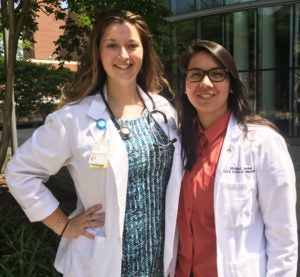Medical Students and Residents
UVA Summer Research Interns

Kelsey O’Leary and Monica Janke, Medical Student Research Interns, Summer 2016
Since the year 2002, DOPS has engaged 2 first year UVA medical student summer research interns in coding cases of children who report memories of previous lives. The medical students apply and are interviewed for this summer research program. They are here for 7-8 weeks during their break from their first and second year of medical school. The students are supervised and trained in the coding procedures in a standardized manner. They are then given access to the files and field notes of the cases of children who remember previous lives. Using standardized procedures, they code the cases for over 200 variables. Once a case is coded, the data is entered into a large SPSS data base. The medical students are then encouraged to create a research project of their own in which they use statistical analysis to look for patterns and and trends in the data. At the end of the summer, the medical students typically give a presentation about their project to the faculty and write a short summary paper. It is possible for these medical student projects to evolve into published academic papers with the guidance and collaboration of the research faculty.
Resulting Academic Papers
Here are examples of summer UVA medical student research projects which eventually became published papers.
Childhood Gender Nonconformity and Children’s Past-Life Memories, authored by Marieta Pehlivanova, Monica J. Janke, Jack Lee & Jim B. Tucker, published in 2018 in the International Journal of Sexual Health. (pdf)
Cases of the Reincarnation Type with Memories from the Intermission Between Lives, by Poonam Sharma and Dr. Jim B. Tucker, published in 2005 in the Journal of Near-death Studies, 23(2):101-118. This project analyzed statements from 35 Burmese subjects, revealing patterns in the memories that they described. A comparison of these reports, to reports of near-death experiences indicates significant areas of overlap between these two types of experiences.
Expanding Our Research
We invite you to review the descriptions of the ways in which the DOPS researchers currently envision expanding their research within special areas of focus.
*Please note, we do not provide course credit or funding to any students, graduate students or medical students for these specially arranged circumstances.
Medical Residents and Visiting Medical Residents
Residents from UVA Medical School or from other approved academic institutions and medical schools may pursue a research project with members of the UVA DOPS faculty. It is possible to set up special research projects related to the scope of what is being studied DOPS, provided that a member of the DOPS research faculty has made arrangements to act as collaborator or an associate supervisor on the project.
Resulting Academic Papers
Here are some examples of published academic papers that came out of specially arranged and approved selected projects with visiting medical students and UVA medical residents. All of these medical students and residents collaborated with Dr. Bruce Greyson around the topic of Near-death experience research.
Characteristics of memories for near-death experiences by Lauren E. Moore M.D. and Bruce Greyson M.D. (Consciousness and Cognition, 51, 116-124, 2017). Near-death experiences are vivid, life-changing experiences occurring to people who come close to death. Because some of their features, such as enhanced cognition despite compromised brain function, challenge our understanding of the mind-brain relationship, the question arises whether near-death experiences are imagined rather than real events. In this study, the researchers administered the Memory Characteristics Questionnaire to 122 survivors of a close brush with death who reported near-death experiences. Participants completed Memory Characteristics Questionnaires for three different memories: that of their NDE, that of a real event around the same time, and that of an event that had imagined around the same time. The Memory Characteristics Questionnaire score was higher for the memory of the near-death experience than for that of the real events, which in turn was higher than that of the imagined event. These data suggest that memories of near-death experiences are recalled as “more real” than real events or imagined events. (pdf)
Near-Death Experiences and Posttraumatic Growth by Surbhi Khanna, MD and Bruce Greyson, MD (The Journal of Nervous and Mental Disease, 203: 10, 749-755, October 2015). Posttraumatic growth denotes positive psychological change after a traumatic experience that is an improvement over the state before the trauma. Inasmuch as it involves existential re-evaluation, posttraumatic growth overlaps with spiritual change, although it also encompasses other domains of positive outcome. This study investigated posttraumatic growth and presence and depth of near-death experience at the time of the close brush with death among 251 survivors of a close brush with death, using the Posttraumatic Growth Inventory and Near-Death Experience (NDE) Scale. Near-death experiences were associated with greater posttraumatic growth than were close brushes with death in the absence of such an experience, and scores of the NDE Scale were significantly correlated with scores of the Posttraumatic Growth Inventory. (pdf)
Do Prevailing Societal Models Influence Reports of Near-Death Experiences? A Comparison of Accounts Reported Before and After 1975 by Geena Athappilly, M.D. and Bruce Greyson M.D. (Journal of Nervous & Mental Disease, 194, 218-222, 2006). This article compares the phenomenology of 24 NDEs that were reported prior to Dr. Raymond Moody’s introduction of the term “NDE” in 1975 with 24 recently reported NDEs, matched on relevant demographic and situational variables. Tunnel phenomena were reported more frequently in the recent NDEs, but 14 other features described by Moody were reported as frequently in the pre-1975 NDEs as they were in the recent cases. This consistency in NDEs reported before and after Moody described the “typical” NDE suggests that NDEs reports have not been substantially influenced by prevailing cultural models.
